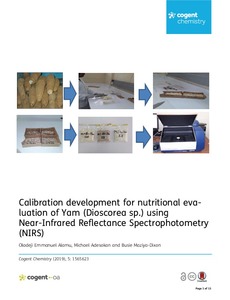| dc.contributor.author | Alamu, E.O. |
| dc.contributor.author | Adesokan, M. |
| dc.contributor.author | Maziya-Dixon, B. |
| dc.date.accessioned | 2019-12-04T11:30:09Z |
| dc.date.available | 2019-12-04T11:30:09Z |
| dc.date.issued | 2019-01-08 |
| dc.identifier.citation | Alamu, E.O., Adesokan, M. & Maziya-Dixon, B. (2019). Calibration development for nutritional evaluation of yam (Dioscorea sp.) using near infrared reflectance spectrophotometry (NIRS). Cogent Chemistry, 5(1565623), 1-13. |
| dc.identifier.issn | 2331-2009 |
| dc.identifier.uri | https://hdl.handle.net/20.500.12478/5206 |
| dc.description | Open Access Journal |
| dc.description.abstract | The aim of yam breeders is to produce many hybrids, which can form the basis of selecting quality nutritional traits and other characteristics using certain agronomic criteria. Chemical methods are employed to determine the main constituents of yam, which are time-consuming, expensive, and involve sample destruction. However, the constraints of lengthy analysis time and the cost needed to analyze thousands of these genotypes are major constraints to yam breeding in Nigeria. This study was undertaken to develop and validate calibration equations on the Near-Infrared Reflectance Spectrophotometer (NIRS) for determining chemical compositions of selected yam genotypes. Equations developed for moisture, ash, protein, crude fiber, and tannin showed high coefficients of determination (R2) for the calibration curve (0.87, 0.84, 0.83, 0.80, and 0.89, respectively) and high to medium coefficients of determination in cross-validation (0.80, 0.68, 0.69, 0.68, and 0.50). The standard errors of calibration (SEC) and the standard errors in cross-validation (SECV) were low for most constituents. A total of 360 ascensions of yam flour were predicted for selected traits to test the equations, and the results were comparable with data from conventional methods. Results of this study have shown that NIRS could be a very useful tool to help yam breeders screen large sample sets using limited resources with very short time. This will enhance breeders’ rapid selection of genotypes at screening stage where many breeding lines are to be evaluated within the shortest time possible. |
| dc.description.sponsorship | Bill & Melinda Gates Foundation |
| dc.format.extent | 1-13 |
| dc.language.iso | en |
| dc.rights | CC-BY-4.0 |
| dc.subject | Yams |
| dc.subject | Calibration |
| dc.subject | Development |
| dc.subject | Proteins |
| dc.subject | Moisture |
| dc.subject | Ash |
| dc.title | Calibration development for nutritional evaluation of Yam (Dioscorea sp.) using Near-Infrared Reflectance Spectrophotometry (NIRS) |
| dc.type | Journal Article |
| dc.description.version | Peer Review |
| cg.contributor.crp | Agriculture for Nutrition and Health |
| cg.contributor.crp | Maize |
| cg.contributor.crp | Roots, Tubers and Bananas |
| cg.contributor.affiliation | International Institute of Tropical Agriculture |
| cg.coverage.region | Africa |
| cg.coverage.region | West Africa |
| cg.coverage.country | Nigeria |
| cg.creator.identifier | Alamu Emmanuel Oladeji: 0000-0001-6263-1359 |
| cg.researchtheme | NUTRITION & HUMAN HEALTH |
| cg.isijournal | ISI Journal |
| cg.authorship.types | CGIAR single centre |
| cg.iitasubject | Nutrition |
| cg.journal | Cogent Chemistry |
| cg.howpublished | Formally Published |
| cg.accessibilitystatus | Open Access |
| local.dspaceid | 102871 |
| cg.targetaudience | Scientists |
| cg.identifier.doi | https://dx.doi.org/10.1080/23312009.2019.1565623 |

